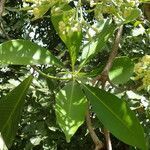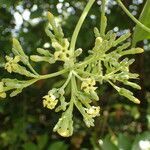Tree 25–30(–40) m high with white latex; trunk up to 1.4 m in diameter, with or without buttresses up to 8 m high; bark grey, white or yellowish, smooth or scaly.. Leaves in whorls of 4–9, petiolate; blade (narrowly) obovate, rarely oblong, 8–19(–24) cm long, 3.5–7.5 cm wide, acuminate, rarely obtuse or retuse at the apex, decurrent into the petiole, coriaceous; secondary veins in 25–50(–60) pairs, forming an angle of almost 90° with the midrib and a neat submarginal vein; petiole 0.6–2.9 cm long.. Inflorescence compound-subumbellate, 7.5–23 cm long, pubescent in all parts; bracts small, sepal-like; pedicel 0.2–0.6 cm long.. Flowers with sepals broadly ovate, 1–2.2 mm long, 1–2.7 mm wide; corolla yellow-green to pale green; lobes pale yellow, rarely white, salver-shaped; tube 6.5–14 mm long; lobes obliquely ovate or obovate, 2.5–6.5 mm long, acute or obtuse; pistil 4.5–11.5 mm long.. Fruits of two linear follicles, 22–57 cm long, 0.2–0.4 cm wide, pubescent, dehiscent; seeds many, in two rows, with a thickened margin, bearing long stiff hairs at the ends and much shorter ones at the side.. Fig. 20 (p. 59).
More
A tree. It grows 25-30 m tall. The trunk can be 1.4 m across. It can have buttresses 8 m tall. The leaves are in rings of 4-9. They are 8-19 cm long by 4-8 cm wide. The flowers are in a compound group 8-23 cm long at the ends of branches. The fruit are 2 long follicles 22-57 cm long by 0.2-0.4 cm wide. They are hairy. There are many seeds in 2 rows.
Paired, narrowly-cylindric fruiting follicles 12-20 in. long.
Tree 30-120 ft. high with whorled leaves and branches
Many-flowered terminal inflorescences
Evergreen and deciduous forest in damp situations. Primary, as well as secondary, moist evergreen to dry semi-deciduous forest at elevations up to 1,200 metres. It is sometimes found in swampy locations and by the sides of streams.
Can be grown by seedlings. Seeds needs soaking.



